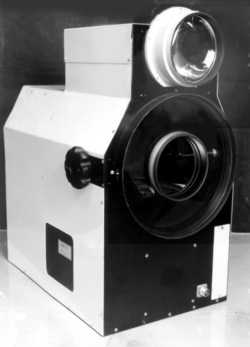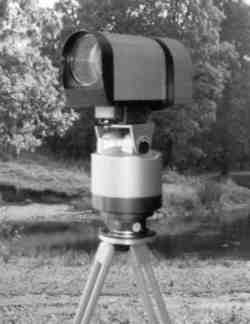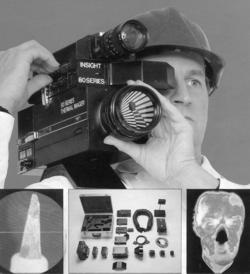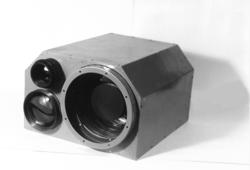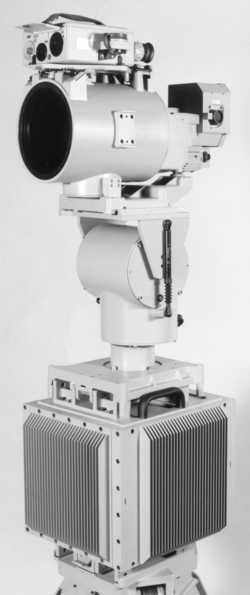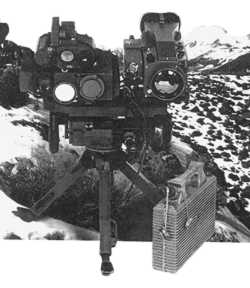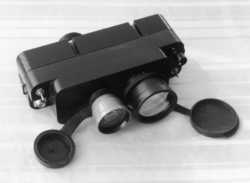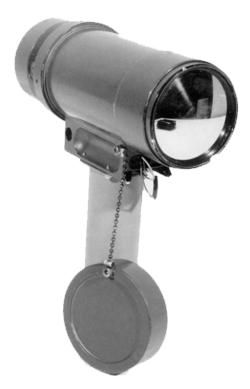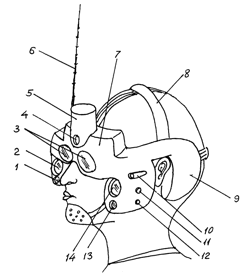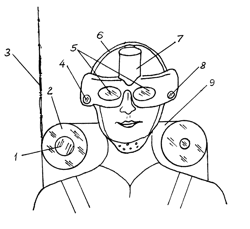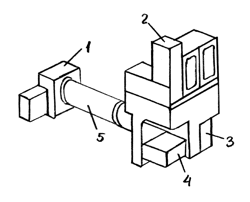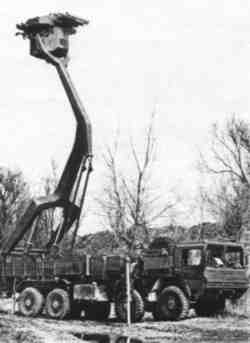| Multi-channel night vision devices for ground use.
Volkov Viktor Genrikhovich, PhD in Engineering, Associate Professor MULTI-CHANNEL NIGHT VISION DEVICES FOR GROUND USE. Currently, night vision devices (NVD) designed for observation at dusk and at night are widely used. And in some cases, also in low atmospheric transparency. NVDs based on electron-optical converters (EOC), low-level television systems (LLTS), thermal imaging (TIV) devices are known. All of them have their drawbacks and, accordingly, limited application capabilities. In this regard, it seems advisable to create multi-channel NVDs (MPNV) consisting of individual channels based on known types of NVDs and other devices in such a way that the disadvantages of some channels would be compensated by the advantages of others. This ensures round-the-clock and all-weather operation of MPNVs. MPNV are used to search for victims during natural disasters, to support exploration, extraction and transportation of minerals, construction and installation, repair work and driving of all types of transport in difficult visibility conditions, environmental control, to support the work of law enforcement agencies, surveillance, aiming, etc. MPNV are divided into complex, combined and integrated.
Complexsystems consist of two or more channels operating in different spectral ranges and combined into a single structure. These channels have one common or several different input windows for different spectral regions. In this case, each channel can operate independently in accordance with its fundamental capabilities. Images are displayed on separate displays for each channel or on a single display, provided that the channels are switched. There is no joint processing of information from individual channels. MPNV can be mounted in several cases, but installed on a single carrier and having functional connections (mechanical, electrical, etc.).
Combinedconsist of two or more channels operating in different spectral ranges and combined both structurally and on the basis of combining optical axes (full or partial). In MPNV there is a common input window, and information is presented either on different or on a common display. The system is mounted in a single housing. Individual channels can operate together or independently. In integratedMPNV individual channels are combined on the basis of a common optical system, as well as a system for processing and presenting an integrated image on a single display. The latter is formed on the basis of analysis of specific features — signals from different channels, signal processing in real time in a microcomputer and presentation in an optimized form on a single display. These devices are still under development. MPNV have all-weather and round-the-clock operation, and under the influence of optical and dust and smoke interference. Due to their increased efficiency, they allow solving the problem of automation of search, detection, identification and aiming, eliminating operator intervention. Passive-active NVDs based on image intensifier tubes, NTVS, TPV devices, heat detectors (TPO), daytime TV systems (DTVS) or daytime optical devices (DOP), active-pulse (AP) NVDs and radar stations (RLS) can be used as separate channels. Passive-active NVDs based on an image intensifier are relatively simple and cheap, provide visibility of both the observed object and the background (terrain) surrounding it, regardless of the temperature contrasts of the object and the background. But these devices cannot operate at a reduced level of natural night illumination (ENI) in passive mode (in this case, the active mode is used — illumination of the object by radiation from an infrared (IR) illuminator built into the NVD, which unmasks the night vision device), with reduced atmospheric transparency (haze, fog, rain, snowfall, etc.), under the influence of light interference and with low natural lighting contrasts of the object with the background. In addition, these NVDs cannot accurately measure the distance to the object. Daytime optical devices have a higher image quality, transmit natural color, are simple, cheap, but do not work at night and have the same disadvantages as NVDs based on image intensifier tubes. For precise range measurement, they are used as a laser rangefinder (LRF) sight. NTVS and DTVS, in comparison with devices based on the image intensifier and daytime optical devices, provide duplication and remote transmission of images, their processing in real time, simple presentation of alphanumeric and symbolic information, to a certain limit — suppression of light interference and precise measurement of coordinates. But all the main disadvantages of night vision devices based on the image intensifier and DTVS are characteristic of low-level and daytime television systems, respectively. In addition, the image quality in NTVS and DTVS is somewhat lower than, respectively, in night vision devices and daytime optical devices with ocular image output. Thermal imaging devices can operate in many cases with reduced atmospheric transparency, in dust and smoke, and under the influence of light interference, if their spectrum does not coincide with the spectral range of the TPV device. The latter functions regardless of the level of natural night illumination and lighting contrasts of the object and the background, and is capable of detecting even hidden objects by their thermal radiation. But compared to low-level television systems, TPV devices have poor image detail and a specific character. Image quality strongly depends on the temperature contrasts of the object and the background. Thermal imaging devices cannot operate in some types of fog. It is difficult to see the horizon line in them, and sometimes the background. The devices are complex, expensive, in some cases they use low-temperature (cryogenic) cooling to 77-80 K, and are not capable of accurately measuring the distance to an object. Heat detectors, unlike TPV devices, are not used to obtain a full-fledged image, but only to indicate the presence of a heat-emitting object in the field of view. TPOs are simpler, cheaper than thermal imaging devices, do not require cooling, but otherwise have the same disadvantages. The principle of operation of active-pulse night vision devices is based on pulsed laser illumination of objects of observation and synchronized pulse control (strobing) of the image intensifier tube in the receiving part of the night vision device. Active-pulse night vision devices provide record-breaking ranges of object identification regardless of the level of ENO and lighting contrasts of objects and backgrounds, operate under the influence of light interference regardless of their spectrum, at reduced atmospheric transparency and provide measurement of the distance to objects with an accuracy no worse than that of modern laser rangefinders. They can also be made in the form of AI NTVS with all the advantages characteristic of them. But active-pulse night vision devices are powerless in smoke and in some types of fog. When working in the active-pulse mode (AI night vision devices can also work in the passive mode, like conventional night vision devices), only the image of the object is visible, and the background is cut off. However, the increased range, its precise measurement and noise immunity are provided only in the AI mode. The small field of view, determined by the narrow angle of illumination of the laser illuminator, prevents the search for objects in the AI mode. The search must be carried out in the passive mode. But here we have to face all the shortcomings of the passive mode of the NVD based on the EOP and the impossibility of achieving in this mode the detection range of the object comparable to the identification range in the AI mode. Radars can operate in virtually any conditions of day and night, in the presence of light and dust and smoke interference, regardless of the level of natural night illumination, lighting and temperature contrasts, with reduced atmospheric transparency. Radars accurately measure the distance to an object and its coordinates. However, radars are subject to the effects of radio interference, and cannot always ensure the identification of terrain elements and objects. It is difficult to work with radar on a stationary object. Thus, none of the listed means operates in the entire range of external conditions, therefore individual devices in the form of channels are combined into MPNV. The following channel combinations are the most promising:
Of all these combinations, the most successful is the MPNV based on combination 5. It guarantees round-the-clock and all-weather operation in the presence of light and dust and smoke interference, accurate measurement of range and coordinates in combination with relatively low weight, dimensions and power consumption. It implements high adaptability, a modular design principle and automated control of the MPNV parameters. Outputting images of AI and TPV channels to a single television monitor allows you to switch to an integrated MPNV, and the use of a built-in microcomputer automates the system. The use of combination 6 will further increase the efficiency of the MPNV, but this will lead to a sharp increase in weight, dimensions and power consumption. Table 1 shows the main parameters of portable MPNV surveillance systems for operation from a tripod. Photos 1–6 show the appearance of these systems. Table 1. Main parameters of portable MPNVs mounted on a tripod.
The thermal imaging channels of all these MPNV operate in the 8-14 µm spectrum range (the most effective in ground conditions), with the exception of the system in Fig. 2, which operates in the 3-5 µm range. The AI channels of all the systems shown are equipped with a generation 2+ image intensifier and illuminators based on powerful pulsed semiconductor laser emitters. Photo 7 shows the ALATS MPNV from Litton Laser Systems (USA) mounted on a tripod. It includes a thermal imager (or TIVR), a laser rangefinder (wavelength 1.55 µm), a microcomputer, a unit for measuring horizontal and vertical angles, a radar signal receiver, and a tripod with a limb. The detection range of objects is 10 km, and their identification is 5 km [19].
In addition to portable systems, hand-held combined MPNVs based on combination 2 are used. Their main parameters are given in Table 2, and their appearance is shown in photos 8-10. The heat detector is based on an uncooled pyroelectric photodetector and operates in the spectrum range of 8-14 µm. These MPNVs are needed to search for victims during natural disasters, in mines, etc. Table 2. Small-sized MPNVs (NVs based on EOP + TPO)
However, the most widespread are combined systems with a 3 5 combination. When implementing them, the problem of optimally combining images of thermal imaging and low-level television channels arises. The difficulty is associated with different laws of image scanning across the frame, its different speeds and frame formats. In this case, it is possible to completely combine TPN and TV images, bring them to a single television standard with subsequent display on a single TV monitor by summing the video signals. But a more rational way of combining images is to displace part of the TV image with a TPN image. In this case, a rectangular “window” is formed in the central part of the television raster, in which the TPN image is presented. When using a color television monitor, the NTFS (DTVS) channel image is usually presented with a predominance of green, and the thermal imaging channel — with a predominance of red. The problem of combining TPN and TV images is disclosed in detail in the work /10/. In Fig. 1 shows the appearance of a head-mounted combined MPNV with remote image transmission.
1 — daytime channel lens; In such a system, images of the TV and AI NTVS channels are integrated using a microcomputer (9). The daytime channel operates at high illumination levels. Dichroic mirrors (3) have coatings that reflect radiation in the glow spectrum of the TV monitor screen into the operator's eye and transmit radiation in the rest of the visible spectrum. Such «through» vision ensures simultaneous observation by the operator of the image from the screen and the surrounding area. This allows avoiding illumination of the NTVS channel during its operation in the passive mode by excess radiation from the luminous devices of the control panel when driving a vehicle. A laser rangefinder with a wavelength of 1.55 μm that is safe for the eyes operates during the day, and a rangefinder for the NTVS channel operates at night. The indicator (10) determines the level of natural illumination for automatic brightness adjustment of the NTVS channel during its operation in the passive mode. Block (7) provides real-time image processing (noise subtraction, contrast enhancement, etc.), conversion of thermal imaging into a television standard, and input of service information into the MPNV. Navigation data is input into the system via a satellite communication system. For MPNV with a longer range, it can be mounted on the operator's shoulder in a backpack (Fig. 2).
1 — lens of a pulsed laser illuminator; When using MPNV in autonomous robotic systems, automatic recognition of objects is necessary. At present, this task is solved using a built-in microcomputer operating according to a specific program. However, in order to increase the speed and attract a larger amount of reference information, it is advisable to use a coherent-optical correlator. Its operating principle is based on the holographic method of recognition by comparing the spatial-frequency spectrum of the analyzed image of objects and holographic matched filters in the memory of the recognition device. The convolution of the Fourier images of the reference and analyzed images is converted into a correlation response of the system to recognition. In this case, the coordinates of the analyzed object are determined simultaneously. The memory capacity of one holographic disk allows storing up to 5,000 reference Fourier images. Processing is performed in real time. In this case, several images can be analyzed simultaneously. Modern correlators have a design suitable for use in MPNV /10/. In addition to portable and handheld systems, there are mobile MPNV on mobile carriers. They are located: 1 — directly on the mobile object; MPNV of the first type are most often used on tanks, infantry fighting vehicles, and armored personnel carriers and are part of the fire control system of these combat vehicles. Consideration of such MPNV deserves a separate review. Here we will limit ourselves to a description of the most typical systems, for example, the HL-60 multichannel stabilized sight (Fig. 3) of the Leclerc tank /11/.
1 – TV monitor of thermal imaging and low-level television channels; The gunner's day channel has magnifications of 2.5 and 10x. The LD channel has a wavelength of 1.06 μm. The low-level television channel is implemented on a CCD matrix. The thermal imaging channel is implemented on the basis of common modules and has field of view angles of 1.9×2.9 ° and 5.7×8.6 °. The commander's day channel, which has a built-in night channel based on the EOP and LD, has the same magnifications as the gunner's day channel and the same stabilization accuracy of 0.05 mrad. The commander has his own TV monitor, which displays the image from the gunner's sight. The microcomputer of these devices performs all the necessary calculations for the normal operation of the tank's fire control system, which incorporates the experience of creating an onboard electronic system for the Mirage-2000 aircraft.Avimo (UK) has created the NV-3001 day/night sight for tanks and armored vehicles. It contains day, night (based on an image intensifier, thermal imaging tube) and LD channels. The day channel and laser rangefinder have an 8x magnification and a field of view of 8°. The LD channel has a wavelength of 1.06 μm. It measures the range within 200–9995 m with an accuracy of ±5 m, the channel on the 2nd generation image intensifier has a 7x magnification and a field of view of 7.5°. The thermal imaging channel has a magnification of 4.9 and 2x, a field of view of 2.25×3.8 and 5.6×9.5°, respectively, an identification range of 1.5 km, and a detection range of 2.5 km. [20]. MPNV on a lifting mast are somewhat less widespread. Celsius Tech Е1естronics (Sweden) has developed a combined MPNV Lemur /12/on a gyrostabilized platform mounted on the roof of a car. The horizontal viewing angle is 360°, vertical +35° -20°. The system includes a thermal imaging channel operating in the 7.5 – 10.5 µm spectrum and having two field of view angles: 9×6.75° and 3×2.25°, a daytime television channel with a field of view of 16×12° and a laser rangefinder with a wavelength of 1.064 µm, measuring range within 200 – 10,000 m. Radamec Defence Systems (Israel) has developed the Radamec System 1000L (photo 11) /13/. The system includes:
Texas Instruments (USA) has developed a mast-mounted reconnaissance system HSS (Hunter Sensor Suite), which includes a 2nd generation forward-looking infrared (FLIR) device, a DTV channel, a laser rangefinder, and acoustic sensors. The MPNV is installed on an HMMWV /14/all-terrain vehicle. In Germany, the companies Krauss Maffei, Euromissil, MAN, MBB created the EPLA (Elevirable Platform) anti-tank system, also designed to combat helicopters. The system includes a gyrostabilized “day/night” sight. The entire complex is mounted on a mast with a lifting height of up to 13 m, mounted on an 8×8 LKW army truck. The HOT ATGM is also mounted on this mast. The system has a range of 1.9 – 4.5 km, and a horizontal viewing angle of 360°. One version of the system provides for the placement of the entire combat crew (3 people) on a lifting platform together with an instrument complex and weapons, while another option provides for the placement of the combat crew in the vehicle cabin. The system includes a radar, a DTV, a MIRA TPV sight, a wide-angle NVD for terrain observation, a night periscope with a 360-degree view and a stabilized mirror head for transmitting images to a TV channel with an ultra-high resolution of 1242 TV lines. The platform can be put into combat readiness in 2 minutes. The platform can be raised to its full height in 12 seconds. The installation of the mast with the platform on a truck is shown in Photo 12 [15].
The MCCS company (Great Britain) has developed the VISTAR IM 405 gyrostabilized system, installed on a telescopic mast up to 8 m high, mounted on a Land Rover vehicle. The system consists of a HTWS and a TPV channel, designed for the spectrum range of 8 — 12 µm. The horizontal viewing angle is ±170 °, vertical — ±30 ° [16]. The AB Wide company (USA) has created the TM170/4.7-1.0 mast system with a mass of 45 kg, installed on a Land Rover vehicle. Lifting limits: 1 — 4.7 m in 20 s. The TM170/10-1.9 TM170/15-2.7 systems from the same company can be raised to a mast height of up to 10 and up to 15 m, respectively, have a weight of 70 and 100 kg, and a lifting time of 40 and 60 s [17]. Thomson-TRT Defense (France) has developed the MOS 2 mast system, which can be mounted on various civilian or military vehicles for use by the police, special forces and forward observers. The system includes TPV, NTVS and LD channels mounted on a gyrostabilized platform. It can operate around the clock and in any weather, providing surveillance of objects and measuring the range to them with an accuracy of up to 5 m. The on-board computer provides automatic detection, tracking of objects and plotting their position on a map. Panoramic surveillance of the terrain is provided [18]. The mast multichannel systems described above are actually a type of helicopter surveillance and targeting systems, which the author hopes to describe in the next review. |


